Related Research Articles

Aegean civilization is a general term for the Bronze Age civilizations of Greece around the Aegean Sea. There are three distinct but communicating and interacting geographic regions covered by this term: Crete, the Cyclades and the Greek mainland. Crete is associated with the Minoan civilization from the Early Bronze Age. The Cycladic civilization converges with the mainland during the Early Helladic ("Minyan") period and with Crete in the Middle Minoan period. From c. 1450 BC, the Greek Mycenaean civilization spreads to Crete, probably by military conquest. The earlier Aegean farming populations of Neolithic Greece brought agriculture westward into Europe before 5000 BC.
Johann Ludwig Heinrich Julius Schliemann was a German businessman and an influential amateur archaeologist. He was an advocate of the historicity of places mentioned in the works of Homer and an archaeological excavator of Hisarlik, now presumed to be the site of Troy, along with the Mycenaean sites Mycenae and Tiryns. His work lent weight to the idea that Homer's Iliad reflects historical events. Schliemann's excavation of nine layers of archaeological remains has been criticized as destructive of significant historical artefacts, including the layer that is believed to be the Homeric Troy.

Mycenae is an archaeological site near Mykines in Argolis, north-eastern Peloponnese, Greece. It is located about 120 kilometres south-west of Athens; 11 kilometres north of Argos; and 48 kilometres south of Corinth. The site is 19 kilometres inland from the Saronic Gulf and built upon a hill rising 900 feet above sea level.

Coventina was a Romano-British goddess of wells and springs. She is known from multiple inscriptions at one site in Northumberland, England, an area surrounding a wellspring near Carrawburgh on Hadrian's Wall. It is possible that other inscriptions, two from Hispania and one from Narbonensis, refer to Coventina, but this is disputed.

The Treasury of Atreus or Tomb of Agamemnon is a large tholos or beehive tomb constructed between 1300 and 1250 BCE in Mycenae, Greece.

A death mask is a likeness of a person's face after their death, usually made by taking a cast or impression from the corpse. Death masks may be mementos of the dead or be used for creation of portraits. The main purpose of the death mask from the Middle Ages until the 19th century was to serve as a model for sculptors in creating statues and busts of the deceased person. Not until the 1800s did such masks become valued for themselves.

The Mask of Agamemnon is a gold funerary mask discovered at the Bronze Age site of Mycenae in southern Greece. The mask, displayed in the National Archaeological Museum of Athens, has been described by the historian Cathy Gere as the "Mona Lisa of prehistory".
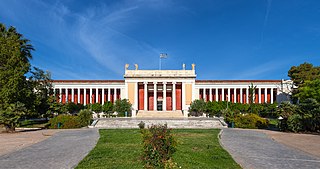
The National Archaeological Museum in Athens houses some of the most important artifacts from a variety of archaeological locations around Greece from prehistory to late antiquity. It is considered one of the greatest museums in the world and contains the richest collection of Greek Antiquity artifacts worldwide. It is situated in the Exarcheia area in central Athens between Epirus Street, Bouboulinas Street and Tositsas Street while its entrance is on the Patission Street adjacent to the historical building of the Athens Polytechnic university.

John Garstang was a British archaeologist of the Ancient Near East, especially Egypt, Sudan, Anatolia and the southern Levant. He was the younger brother of Professor Walter Garstang, FRS, a marine biologist and zoologist. Garstang is considered a pioneer in the development of scientific practices in archaeology as he kept detailed records of his excavations with extensive photographic records, which was a comparatively rare practice in early 20th-century archaeology.
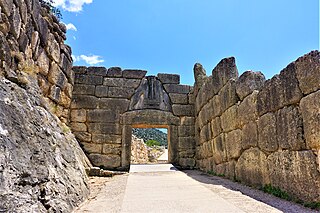
The Lion Gate is the popular modern name for the main entrance of the Bronze Age citadel of Mycenae in Southern Greece. It was erected during the thirteenth century BC, around 1250 BC, in the northwestern side of the acropolis. In modern times, it was named after the relief sculpture of two lions or lionesses in a heraldic pose that stands above the entrance.

Carrawburgh is a settlement in Northumberland. In Roman times, it was the site of a 3+1⁄2-acre (1.5 ha) auxiliary fort on Hadrian's Wall called Brocolitia, Procolita, or Brocolita.
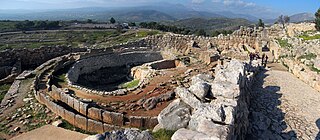
Grave Circle A is a 16th-century BC royal cemetery situated to the south of the Lion Gate, the main entrance of the Bronze Age citadel of Mycenae in southern Greece. This burial complex was initially constructed outside the walls of Mycenae and ultimately enclosed in the acropolis when the fortification was extended during the 13th century BC. Grave Circle A and Grave Circle B, the latter found outside the walls of Mycenae, represents one of the significant characteristics of the early phase of the Mycenaean civilization.

The Tomb of Clytemnestra was a Mycenaean tholos type tomb built in c. 1250 BC. A number of architectural features such as the semi-column were largely adopted by later classical monuments of the first millennium BC, both in the Greek and Latin world. The Tomb of Clytemnestra with its imposing façade is together with the Treasury of Atreus the most monumental tomb of that type.

There have been many discoveries of gold grave goods at Grave Circles A and B in the Bronze Age city of Mycenae. Gold has always been used to show status amongst the deceased when used in grave goods. While there's evidence that the practice of grave goods and monumentalizing graves to show status was used throughout Ancient Greece from the Bronze Age and passed through the Classical Period, the goods themselves changed over time. However, using gold as a material was a constant status marker. At the Grave Circles in Mycenae, there were several grave goods found that were made out of gold; masks, cups, swords, jewelry, and more. Because there were so many gold grave goods found at this site there's a legend of Golden Mycenae. Each family group would add ostentatious grave goods to compete with the other family groups for who is the wealthiest. There was more gold found at Grave Circle A and B than in all of Crete before the late Bronze Age.
Lindsay Allason-Jones, is a British archaeologist and museum professional specialising in Roman material culture, Hadrian's Wall, Roman Britain, and the presence and role of women in the Roman Empire. She is currently a visiting fellow at Newcastle University.

The death masks of Mycenae are a series of golden funerary masks found on buried bodies within a burial site titled Grave Circle A, located within the ancient Greek city of Mycenae. There are seven discovered masks in total, found with the burials of six adult males and one male child. There were no women who had masks. They were discovered by Heinrich Schliemann during his 1876 excavation of Mycenae.
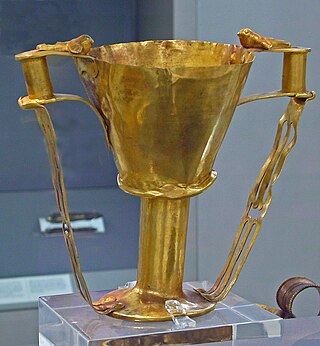
The Cup of Nestor or dove cup is a gold goblet discovered in 1876 by Heinrich Schliemann in Shaft IV of Grave Circle A, Mycenae, which is usually dated to the 16th century BC. It is now in the National Archaeological Museum, Athens.

Clytemnestra, also known as Clytemnestra after the Murder, is an 1882 oil painting by John Collier. It has been held by the Guildhall Art Gallery, in the City of London, since 1893. A second version, c. 1914, is held by Worcester City Art Gallery & Museum.
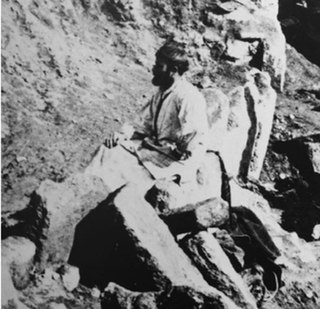
Panagiotis Stamatakis was a Greek archaeologist. He is noted particularly for his role in supervising the excavations of Heinrich Schliemann at Mycenae in 1876, and his role in recording and preserving the archaeological remains at the site.

The Tomb of Aegisthus is a Mycenaean tholos tomb located near the citadel of Mycenae, Greece. It was constructed in the Late Helladic IIA period, approximately 1510–1450 BCE, and rediscovered in the 19th century. It was first excavated by Winifred Lamb in 1922, as part of a project led by Alan Wace.
References
- ↑ Schliemann, Heinrich (1878). Mykena.
- ↑ "The Mask of Agamemnon: An Example of Electroformed Reproduction of Artworks Made by E. Gilliéron in the Early Twentieth Century". The Metropolitan Museum of Art. Retrieved 24 May 2017.
- ↑ "Behind the Mask of Agamemnon - Archaeology Magazine Archive". archive.archaeology.org. Archived from the original on 17 March 2013. Retrieved 24 May 2017.
- ↑ "Horse engraving on bone". Explore. British Museum. 2011. Archived from the original on 2011-10-16. Retrieved 2024-06-24– via Wayback Machine.
- ↑ Sieveking, Ann (1987). A catalogue of palaeolithic art in the British Museum. London: British Museum. pp. 112–. ISBN 978-0-7141-1376-0 . Retrieved 2011-10-14.
- ↑ Pettitt, P. B. (2003). "Discovery, nature and preliminary thoughts about Britain's first cave art". researchgate.net. Retrieved 2018-01-02.
- ↑ Allason-Jones, Lindsay; McKay, Bruce (1985). Coventina's Well: a shrine on Hadrian's Wall. Hexham: Trustees of the Clayton Collection. ISBN 0-946897-05-0.
- ↑ "Thousand miles nile - Egyptology". Cambridge University Press. Retrieved 24 May 2017.
- ↑ "Sir John Hubert Marshall (Biographical details)". britishmuseum.org. Retrieved 24 May 2017.
- ↑ "John Garstang". Britannica.com. Retrieved 24 May 2017.
- ↑ "Smith, George 1840-1876". worldcat.org. Retrieved 16 May 2017.